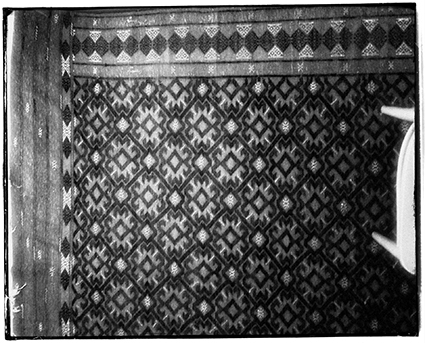For the Dutch, the Eighteenth century wasn’t the best of times. We weren’t happy back then, we had fought and lost wars, the East Indian Trading Company had fallen flat on its face. So much for world supremacy. We simply stuck our heads under the pillow and let all those pretty frivolous frills pass us by, we were too hurt and too Calvinistic for that. Maybe that wasn’t such a stupid move – after all you cannot, against all odds, keep on pretending you are still the most powerful nation in the world (I’m looking at you, Britain). We did continue our colonial shenanigans but that only made matters worse. Artwise we were a bit of a mess.
Why am I bringing this up? Where does it lead to? To Romanticism. Yet again. That enormous, overwhelming movement that started in the Eighteenth century, very much a reaction to the rationalism of the Enlightenment. And this time we aren’t just focusing on desolate landscapes – today it gets really scary. Spooky!
In 1764 young Horace Walpole, the son of the British Prime Minister, wrote a novel: The Castle of Otranto. It is said to be a rather mediocre book, but it is considered to be the first ‘Gothic Novel’, making it the start of a steadfast movement within romanticism. Gothic – an English term for an international cultural phenomenon. At first used in a derogatory manner, its meaning shifted halfway through the 18th century. Art historians began to appreciate the characteristics of Gothic architecture – the meaning ‘medieval’ remained, but the negative connotation disappeared. It intertwined with the supernatural, after all the Dark Ages formed a perfect backdrop for a world full of ghosts, vampires, undead, and droves of their innocent victims.
From the beginning of the 19th century, all this creepiness had a more or less unforeseen side effect: blinding aesthetics. Painting was of course an ideal way of visualizing the Middle Ages, Arthurian legends, fears and frights – every aspect that makes up Gothic. Just like the theater, where Shakespeare was being rediscovered, and where the developing classical ballet also offered endless possibilities to bring the supernatural to life.
In Great Britain in particular, people were actually living Gothic-style. During the Victorian era entire neigborhoods were built that could have provided the phantoms and the doomed with turn-key accommodation. Apparitions, messages from beyond and live-in ghosts included.

Joseph Wright of Derby, 1768. ‘The experiment with the air pump’. I told you he’d be coming back! Here we see Gothic in its ‘Fear of Science’ mode. It all seems very rational, but clearly the scientist is a madman, the lighting scares the poop out of us and the weather isn’t helping either.

Henry Fuseli, 1793. ‘Hamlet’. One of many paintings depicting Shakespeare scenes, by the Swiss/British painter. Shakespeare inundated his plays with fantasy figures (no wonder he regained fame). In this scene the rebellious young prince scolds his mother, in an attempt to avenge his murdered father. Whose ghost immediately appears to calm him down. I totally love the expression on his dead face: “What to do with this hothead of a son? Dad isn’t angry, he’s just really disappointed”.

Another Fuseli. ‘The Nightmare’, 1781. Undoubtedly his most famous painting. The horse in question is on the left, same weird eyes as Hamlet Sr.

This is William Blakes ‘Ghost of the flea’, 1820. Blake, the visionary who traveled the world (and time) in his paintings and poems, but who in reality never left London. Unrecognized in his day, he is now considered a genius loner, ultimately Gothic.

Caspar David Friedrich. Another reappearance. ‘The Abbey in the Oakwood’, 1810. With every painting I pick, I think to myself “It doesn’t get more Gothic than this”, and now I’m really writing it down, too. Isn’t it insane? Could also be used for a very,very, VERY scary version of Swan Lake.

Théodore Géricault, 1818, The raft of the Medusa. Journalism goes Gothic. In 1816 the French naval vessel the Medusa got shipwrecked. The incident caused a huge uproar – apparently the captain got himself into safety, but his crew, all one-hundred-and-fifty of them, ended up on a wonky raft, stuck on the ocean for weeks. Only fifteen of them survived, mainly by eating their dead raftmates. Géricault shows the moment where a dot appears on the horizon: the ship that will save them. A true child of his time, he covers reality with a thick, highly romantic blanket. Actually, his own life too, was pretty romantic (or shall we say Gothic): his studio was full of half-dissected horses and humans, he got his aunt pregnant, hid in Italy after that, painted a series of portraits of psychiatric patients, and died at 32, probably of syphilis.

William Holman Hunt, Isabella and the pot of basil, 1867. One of the founders of the Pre-Raphaelite Brotherhood. Those guys are the very incarnation of the Gothic soul. They need their own separate post, but I’m squeezing this painting in here. This is Isabella, originally from the Decamarone, who hid the severed head of her lover in a pot of basil. As one does. Holman Hunts wife died in childbirth, but in spite of that – or because of it – he used her as a model here.

Photography, the new medium, proved a perfect way to make the dead live forever. Corpses were dressed to the nines and then the photographer was called in. By the way, there’s a persistent rumor that all very early photos of people were of dead bodies, on account of the crazy long exposure times. Although it is probably an urban myth. Either way, this particular person appears extremely dead. But then again, I once had a student who told me he slept in a coffin. Lovely guy, great photographer. And deliciously Gothic.

What a wonderful read this is. Visually and literally – I’m all filled up…. Thanks.
LikeLike